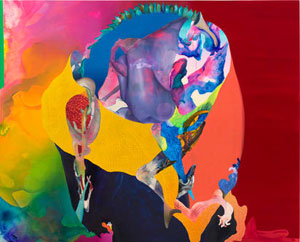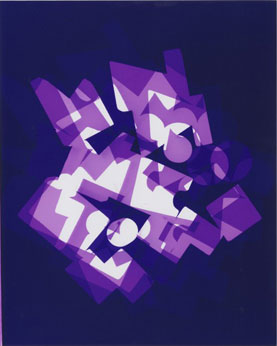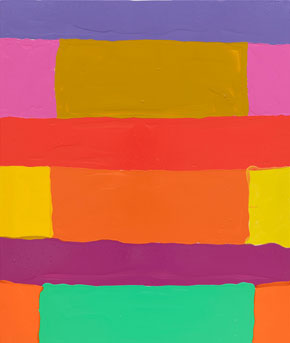Richness or Rigor?
John Haberin New York City
Overflow, Afterglow: Chromatic Figuration
Yto Barrada: Photography
Hasani Sahlehe, Patrick Wilson, and Abstraction
Ask an artist about what went into a work, and you may hear quite a story about myths and memories. You will have your own stories at that—of what you have experienced, seen in the art you love, heard from your parents, and read. And curators attuned to gender and culture eat it up.
Ask again, though, about what the artist had in mind, and you may hear something far more modest. I just want to make art, some might say, to see its color and the light.  The seven artists in "Overflow, Afterglow" get to have it both ways, the stories and the light—and the Jewish Museum wants it all. It sees, as the show's subtitle has it, "Chromatic Figuration," and it sees a trend. With just one artist much past forty, it hopes to lead the way to the future. But will the afterglow fade all too quickly, and is the overflow a bit much?
The seven artists in "Overflow, Afterglow" get to have it both ways, the stories and the light—and the Jewish Museum wants it all. It sees, as the show's subtitle has it, "Chromatic Figuration," and it sees a trend. With just one artist much past forty, it hopes to lead the way to the future. But will the afterglow fade all too quickly, and is the overflow a bit much?
Minimalism begged to retire old ways of understanding art. To speak of a mirror or window onto nature seemed to call for something outside art beyond the thing itself. What is nature anyway, and why do you need to know? At the same time, Minimalism insisted on the painted object in the gallery and on the picture plane. And that introduced a new platitude and a new need to look for rectangles, the grid. And then the revival of painting for the millennium blew that demand out of the water.
Is it ever time to retire an old metaphor? Is it ever time to retire a love of painting for its own sake? Never, I hope, which is what keeps bringing me back to abstract art. "Chromatic Abstraction" pleads for richness rather than rigor, while its artists are not all that expansive or abstract. Yto Barrada at the International Center of Photography finds abstraction lying around the darkroom, along with enough trash to call it Pop Art. Hasani Sahlehe and Patrick Wilson, in turn, bring things right back to the grid and the metaphors.
After the Glow
Chromatic figuration may sound more like color charts and color wheels than an afterglow. It may not, in fact, sound much like figuration. Yet the wall between abstraction and representation has been crumbling for years now, as geometry has given way to excess. With "Overflow, Afterglow," regular shapes are nowhere in sight, but everything else is, and the break with Minimalism's white cube begins with the installation. Each artist gets a bay of angled walls, each at a different angle and painted a different color. Together, they fill a single room, with sightlines from one to next.
Figuration, too, can be elusive, although Rosha Yaghmai insists that sheer color is figurative. Portraits by Sasha Gordon look conventional enough, but notably short of joy or affection. Others may tell stories, but the stories are hard to hear. Sara Issakharian includes hands, snakes, charioteers, and an eastern goddess in mortal combat, but who knows who is winning this war? Austin Martin White throws in a "hypothetical" African sculpture, but his heart is in chaos. Sula Bermúdez-Silverman promises a take on colonialism, but it never extends beyond work with actual rubber and sugar.
Color itself enters in different ways. It comes brushed on wildly, layered on beeswax, and squeezed through a nylon mesh. It can have what the museum calls "supernatural color" or the paleness of skin tones. It comes shining from resin and uranium glass. It all but bleeds out of a silicon trans figure by Chella Man, with the scars of multiple operations in its crotch. It lies nude on its back, ready for more.
The artists do share strategies. Ilana Savdie imagines narratives of hunters and their prey, while Gordon's women train their rifles on a bird, the only thing separating or connecting them. Issakharian has her scenes of combat and celebration, White his Bacchanalia. Rosha Yaghmai paints on cotton and organza, creating moiré patterns, much like White's nylon mesh. These are Yaghmai's "afterimages," and they appear and vanish before one's eyes. The curators, Liz Munsell and Leon Levy, see "uncanny luminescence" everywhere, and at last they get it.
Not all the artists are Jewish, and those that are come with hyphens, like Issakharian, an Iranian Jewish immigrant, and Man, Jewish Chinese. For Bermúdez-Silverman, a hyphenated name and her dollhouse alike speak of home. They suit a time of pride in shifting identities. They are also new to New York museums (although one has showed with an upscale dealer and museum veteran, Jeffrey Deitch), but are they the future? They occupy the same exhibition space as "New York: 1962–1964" in 2022, which looked back to a time when the Jewish Museum introduced an entire generation, from Pop Art to formalism. Can it happen again?
The artists, the museum argues, "take on and take in the oversaturation of our contemporary moment," but do they merely succumb to it? When "color is flexible and amorphous," can it stand for anything at all? To think back to 1962, more than one critic looked at the dizzying designs of Bridget Riley and saw a movement. It must have seemed the next big thing, where in retrospect it was the field of play for little more than a singular talent. Could "chromatic figuration," with all its failed narratives and optical activity, be the Op Art of today? It could be just as passing and a lot tackier.
Part-time silent comedian
Yto Barrada photographed Gibraltar, near her African home town, as a touch point for North Africans in the treacherous passage to safety. She embraced it, too, for the sun and sea. That was 1999, but even now she is traditional enough to work not digitally, but in the darkroom. At the International Center of Photography, you may wonder if she ever leaves its confines, even with a camera. She prefers photograms, of candy wrappers and child's toys, as a cavalcade of overlapping colors and blocks of light. Sweet.
You may not think of Barrada as a photographer, but she began as one. She graduated from the one-year programs at ICP in 1996—then in a Fifth Avenue mansion that could have converted anyone to the medium. Now she returns home several times over. She was back in the darkroom ten years ago, on her return to New York, and she has a solo show at her old school of the results, while recent graduates of those programs share their work a floor above. It may not define her once and for all, but it helps broaden the museum's self-definition. She may never become a full-time photographer, but she is, as the show has it, "Part-Time Abstractionist."
 Actually Barrada has had several homes and successive media. Born in Paris to Moroccan parents in 1971, she spend much of her childhood in Tangier, studied at the Sorbonne, and co-founded a cinema art house in Tangier as well. She exhibited at the LMCC Art Center on Governors Island in 2020, with Bettina Grossman (or simply Bettina) as her guest. Her work there included sculpture, installation, and abstract art (and I leave you to my review then for more). Now she brings a long overdue touch of color to the barren, pebbled courtyard of MoMA PS1. The piled cubes of Le Grand Soir look like attempts at grand pyramids that never quite made it—or just long overdue seating.
Actually Barrada has had several homes and successive media. Born in Paris to Moroccan parents in 1971, she spend much of her childhood in Tangier, studied at the Sorbonne, and co-founded a cinema art house in Tangier as well. She exhibited at the LMCC Art Center on Governors Island in 2020, with Bettina Grossman (or simply Bettina) as her guest. Her work there included sculpture, installation, and abstract art (and I leave you to my review then for more). Now she brings a long overdue touch of color to the barren, pebbled courtyard of MoMA PS1. The piled cubes of Le Grand Soir look like attempts at grand pyramids that never quite made it—or just long overdue seating.
ICP displays sculpture and video, too, in a small show curated by Elisabeth Sherman. A makeshift vase holds cardboard flowers, while the video takes her from the darkroom to an arid but tempting suburban landscape. Cars with what might be a hearse at its front pass homes whose only face rotates open and shut, like an oversize garage door. The procession reaches a traffic circle without heeding the temptation to turn, on its way to what must remain unseen and unknown. As the cars pass, red and white striped curbs swell into red along the pavement, and palm trees sink into the ground and rise once more. They, too, are part-time abstraction.
Are they playful in tone, formal exercises, or deeply allusive—much as the houses might pass for toys, Minimalist sculpture, or the American southwest? Do they belong at all at ICP? Whatever your answer, do not be too sure. The year's celebration of "ICP at 50" recalled its founding mission, to promote photojournalism and a concern for humanity. Barrada earned her certificate in documentary photography as well. Yet ICP's anniversary show also saw a broadening as far as abstraction, and so does she.
Barrada does not need a camera to approach the heights of abstraction. She relishes darkroom tools, like dodge and burn, and rescues paper from the trash. A sewing machine without thread punches its way through more paper, leaving first vertical and horizontal axes, then parallel lines between them. By the time she is done, she has a near textbook reproduction of a black painting by Frank Stella. In the one series with a camera, plumbing supplies from Tangier look like actors in a silent comedy. Take it seriously, but keep smiling.
Ideas for abstraction
Hasani Sahlehe does not make stripe paintings. So why does his work seem, at least at first, to come down to horizontals with enhancements? The stripes are a bit wide as horizontals go, and he lays them on thickly, in acrylic gel. The medium gives each one the potential to lie flat or to shine. They give direction to fairly large paintings, vertical in format, with no bare canvas showing. Less than half, though, make it all the way across.
They cannot make it because shorter fields of color, close to verticals, get in the way. One could describe them as framing the horizontals, for frames within but refusing to mirror the complete painting. Fields depart from the grid in more subtle ways as well, besides their apparent thickness. They may have slightly curved edges, and which call attention to the overlap. Still, colors are bright, clean, and clear. An old way of painting looks both familiar and new. 
In all these ways, a grid becomes a process, and Sahlehe calls the show "Song Ideas," as if to apologize for a work in progress. I cannot swear that they sing, but try not to ask for too much. A Georgia-based painter is not in the loop regardless, right? Not so fast. He shares the gallery with a group show that includes a hot artist, Xylor Jane, and a survivor, Joan Snyder, with no apologies necessary. The work leaves nothing further to do, other than to make more paintings.
I should be remiss not to credit the gallery. The artists who showed there before moving on would make a good wrap-up of the revival of painting all by themselves. Carrie Moyer , for one, has her latest with another newcomer to Tribeca. I have written about her more than once, with admiration for her fluid colors on a wide-open canvas, so just a quick mention, if I may. This time, seeming biological appendages add a further layer to all-over compositions, also enriched by pumice and ground semi-precious stone. They add to the varied application of paint, like spatters, as much as to its texture.
Speaking (yet again) of painting as mirror or window, Patrick Wilson makes it inescapable. His pale blues with the sheen of a mirror or window pane alone would do so. He builds on rectangles of translucent color, each framed with a narrower field of the same color. Then he messes up the picture by arranging them in two columns or offset from one another. If a Minimalist would ask that color and the grid alone make a painting, Wilson is fine with that. They keep moving all the same.
This gallery has four spaces in Chelsea alone, and it favors abstraction. Everything looks good, but what stands out? Suzanne Caporael, in the gallery's original space, takes pains with such familiar geometries. They could go unnoticed, were they not embedded in the indeterminate space of darker fields. Next door, Rico Gatson once again applies checkerboards of the simplest colors to anything from seeming warheads to patterns of radiation. If he is just calling attention to himself, give the credit or blame to painting.

"Overflow, Afterglow" ran at the Jewish Museum through September 15, 2024, Yto Barrada at the International Center of Photography through September 2, Hasani Sahlehe at Canada through October 5, Carrie Moyer at Alexander Gray through October 26, and Patrick Wilson and others at Miles McEnery through October 26.




